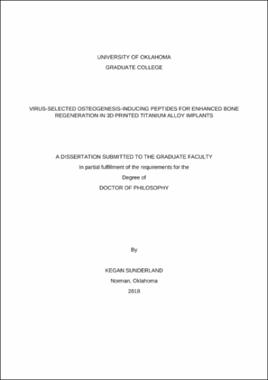| dc.description.abstract | Bone morphogenetic proteins (BMPs) are part of the transforming growth factor-β superfamily and function as key regulators of cellular growth, differentiation, and tissue formation. While recombinant BMPs can be used to induce osteoblast differentiation, they are expensive to produce. In contrast, peptides can be efficiently produced in massive quantities through phage display. It would therefore be highly valuable to develop short peptides capable of mimicking BMPs which could be displayed on human-safe M13 phage. I have discovered short, 12-mer peptide sequences through a selective process called biopanning (patented). These 12-mer peptides have been shown to bind the BMP receptors on live cells by immunofluorescence and bind the BMP receptors in an ELISA when genetically displayed on the p3 coat protein of M13 bacteriophage. The peptides were then genetically displayed on the p8 coat protein of M13 bacteriophage. The p8 coat protein can have up to ~2700 copies of the peptide instead of just 5 available copies on the p3 coat protein. These newly engineered phages were incorporated into phage films having aligned ridge groove surface topographies which are arranged in a way that the p8 coat protein is exposed. Human mesenchymal stem cells (hMSCs) cultured on these films demonstrated varying levels of differentiation according to the peptide displayed as well as the concentration of the peptide. Differentiation of the hMSCs into osteoblasts was confirmed by immunofluorescence and qPCR of the osteoblast marker proteins and genes respectively for osteopontin, osteocalcin, and collagen type 1a. Additionally, calcium deposition was observed to be exceptionally high for hMSCs cultured with the phage films compared to a leading company product, osteogenic media from Lonza. The mechanism of osteoblast differentiation for the two best peptides has also been determined through studying key target points as well as inhibition studies among the major osteogenic signaling pathways: BMP, Hedgehog, Wnt/β-Catenin, and Notch. These peptides follow two pathways, the Hedgehog and the BMP pathways independently. Additionally, the ridge groove 3D structure of the phage film contributes largely to differentiation through the Notch signaling pathway. The peptides displayed on phages were then directionally aligned on 3D printed porous titanium scaffolds using a double-sided freeze casting method. These scaffolds have Young’s moduli and maximum strength not significantly different from natural bone before and after implantation demonstrating no degradation. Upon implantation of the peptide displaying phage-coated titanium implants in a rat radial bone defect model, bone regeneration was observed through Micro-CT, Von Kossa Staining, and H&E staining. Furthermore, the peptide-coated scaffolds showed greater bone regeneration around and within the scaffolds. The success of this work establishes a new technique whereby growth factor mimetic peptides can be discovered and used to coat implantable materials for tissue regeneration. | en_US |
